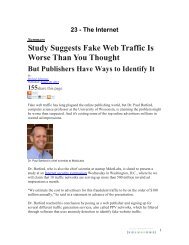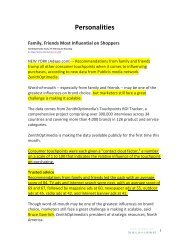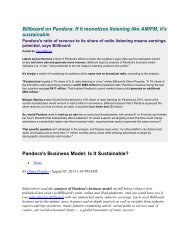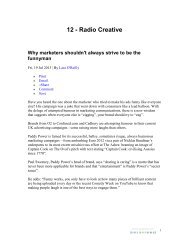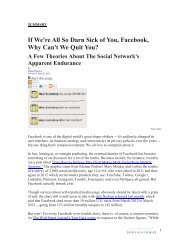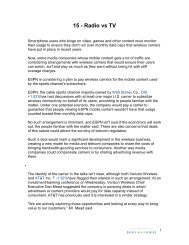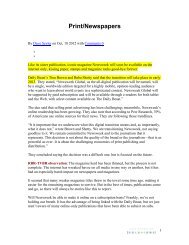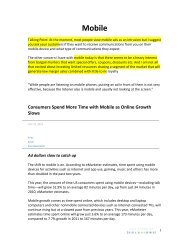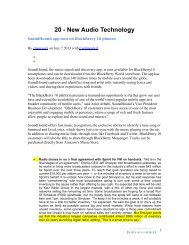Mobile - Katz Marketing Solutions | Radio Advertising | Media Agency
Mobile - Katz Marketing Solutions | Radio Advertising | Media Agency
Mobile - Katz Marketing Solutions | Radio Advertising | Media Agency
You also want an ePaper? Increase the reach of your titles
YUMPU automatically turns print PDFs into web optimized ePapers that Google loves.
The study also found a jump in brand recognition. Fifty-five percent of the consumerswho only watched the TV ad remembered the ad afterwards. When the was ad shownacross TV, smartphone and tablet platforms, 93 percent of consumers remembered seeingthe ad, which is a 69 percent increase from the sample group of TV-only consumers (seestory).Companies across the Internet continually proclaim mobile ads as the next great frontier.Pandora <strong>Media</strong> (P), Twitter, and other big names often derive the majority of theirrevenue from them. On Oct. 23, Facebook‘s (FB) stock leapt more than 10 percent onnews that the social network earned 14 percent of its third-quarter revenue from mobileads, up from almost nothing in the first quarter. That mobile advertising should be anenormous business makes sense. After all, our smartphones are always with us, knowwhere we are, and collect far more data about us than a desktop PC. So if mobile has suchpotential, why are the ads so mediocre?―Most mobile advertising is done as an afterthought,‖ says Eric Picard, chief executiveofficer of Rare Crowds, an ad technology company. ―Immature designers have just sortof slapped banner ads in there.‖ Working with a tiny canvas—a smartphone display—most ads take one of two forms, each with obvious shortcomings. There is the tiny bannerad Picard refers to, which has little room to say anything more than ―Click here forsomething!‖ and the interstitial, the screen that pops up and interrupts you while you‘retrying to read something else.These two simple forms have their roots in other media—only in other media they makea lot more sense. A print advertisement or, for that matter, a Web ad on a computer‘slarge display, is based on the concept of adjacency: We tolerate it because it‘s next tocontent we want to consume. Television ads work the same way (at least for peoplewithout DVRs), but with the added dimension of time. Modern Family will beinterrupted, sure, but the show‘s story structure is designed for that, and we‘ll sit throughsome commercials because we want to see what‘s going to happen with Phil Dunphy‘snext crazy scheme to surprise Claire.When we encounter a mobile ad, it‘s disruptive, and not in the positive way that businessgurus breathlessly use the word. ―When I see an ad pop up on my phone, I get scared,‖says Al Rotches, a Web ad designer who has worked on Internet campaigns for BarackObama, Honda Motor (HMC), and Trojan Brand Condoms (CHD). ―When I‘m on myphone, this is my thing,‖ he adds. ―I don‘t want to be tracked, I don‘t want to beinterrupted.‖Worldwide mobile-ad spending will reach $6.4 billion this year and more than $23.6billion by 2016, according to researcher EMarketer. Google (GOOG) is the biggestbeneficiary, but even it realizes that banner ads and interstitials aren‘t going to work on asmartphone. The company has been developing enhanced ad services like click-to-callbuttons, which allow people to contact an advertiser directly about an offer using thephone in their hand. Its Android devices also can use Google Now, a virtual personalassistant that keeps track of your frequently visited locations and repeating calendar167



